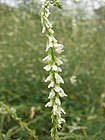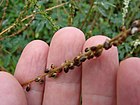Note: This is a project under development. The articles on this wiki are just being initiated and broadly incomplete. You can Help creating new pages.
Melilotus alba
Melilotus albus, known as honey clover, white melilot (UK), Bokhara clover (Australia), white sweetclover (USA), and sweet clover, is a nitrogen-fixing legume in the family Fabaceae. Melilotus albus is considered a valuable honey plant and source of nectar and is often grown for forage. Its characteristic sweet odor, intensified by drying, is derived from coumarin.
Contents
[hide]- 1 Uses
- 2 Parts Used
- 3 Chemical Composition
- 4 Common names
- 5 Properties
- 6 Habit
- 7 Identification
- 8 List of Ayurvedic medicine in which the herb is used
- 9 Where to get the saplings
- 10 Mode of Propagation
- 11 How to plant/cultivate
- 12 Commonly seen growing in areas
- 13 Photo Gallery
- 14 References
- 15 External Links
Uses
Anticlotting agent for the blood, Ointments for external ulcers.
Parts Used
Chemical Composition
Objective To study the chemical constituents of Melilotus officinalis. Methods The compounds were isolated and purified by silica gel column chromatography, gel chromatography, and ODS column chromatography. Their structures were elucidated by chemical and spectral analyses. Results Twelve compounds were obtained from the 70% ethanol extract of M officinalis and their structures were identified as β-sitosterol (1), coumarin (2), methyl 3-(4-hydroxyphenyl)propionate (3), kaempferol-3-O-α-L-rhamnoside (4), rutin (5), apigenin-7-O-β-D-lutinoside (6), dibutyl phthalate (7), robinin (8) clovin (9), kaempferol-3-O-rutinoside (10), isoquerecitrin (11), and medicarpin 3-O-β-glucopyranoside (12). [1]
Common names
| Language | Common name |
|---|---|
| Kannada | |
| Hindi | |
| Malayalam | |
| Tamil | |
| Telugu | |
| Marathi | NA |
| Gujarathi | NA |
| Punjabi | NA |
| Kashmiri | NA |
| Sanskrit | |
| English | Honey clover, White melilot, Bokhara clover, White sweetclover |
Properties
Reference: Dravya - Substance, Rasa - Taste, Guna - Qualities, Veerya - Potency, Vipaka - Post-digesion effect, Karma - Pharmacological activity, Prabhava - Therepeutics.
Dravya
Rasa
Guna
Veerya
Vipaka
Karma
Prabhava
Habit
Identification
Leaf
| Kind | Shape | Feature |
|---|---|---|
| Simple | Alternate | The leaves are compound (made up of two or more discrete leaflets |
Flower
| Type | Size | Color and composition | Stamen | More information |
|---|---|---|---|---|
| Unisexual | Small | white | 5 | There is only one way to evenly divide the flower (the flower is bilaterally symmetrical). |
Fruit
| Type | Size | Mass | Appearance | Seeds | More information |
|---|---|---|---|---|---|
| Simple Fruit | 3–5 mm | The fruit is dry but does not split open when ripe | {{{6}}} |
Other features
List of Ayurvedic medicine in which the herb is used
Where to get the saplings
Mode of Propagation
How to plant/cultivate
The plant is a good green manure crop[20, 87, 172]. It can be sown in the autumn and overwintered or sown from spring to mid summer. It can be cut several times for compost material before being finally incorporated into the soil[87]. Soil: L = light (sandy) M = medium H = heavy ... Moisture: D = dry M = Moist We = wet Wa = water. Growth: S = slow M = medium F = fast. [3]
Commonly seen growing in areas
Photo Gallery
References
External Links
- Ayurvedic Herbs known to be helpful to treat Anticlotting agent for the blood
- Ayurvedic Herbs known to be helpful to treat Ointments for external ulcers
- Herbs with Leaves used in medicine
- Herbs with common name in English
- Habit - Herbs
- Index of Plants which can be propagated by Seeds
- Herbs that are commonly seen in the region of Meadows
- Herbs



